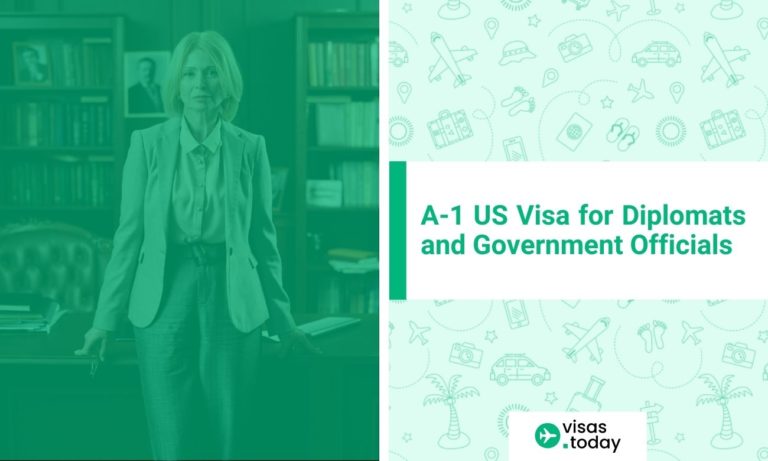The A visa, also known as a diplomatic or official visa, is one of the most advantageous visas to receive for non-immigrant travel in the United States. It is aimed at foreign ambassadors and officials seeking entry to the United States. The diplomats must have a compelling reason for travelling and cannot travel for pleasure.
If you would like to know what exactly the A-1 visa is, including their types, how to apply, and other details, read on.
- Who is eligible for the A-1 US Diplomats Visa?
- US Diplomatic Visas Types
- What is the US A-1 Visa?
- A-1 US Visa Requirements
- The A1 US Diplomats visa Privileges
- What is the procedure for obtaining an A-1 visa?
- How long does the A-1 visa take to process?
- How long does the A-1 visa last?
- Is the A1 Visa for Diplomats extendable?
- Can I bring my Dependents on an A-1 visa?
Who is eligible for the A-1 US Diplomats Visa?
All A form visa applicants must demonstrate that they have a compelling reason for travelling. This ensures that A visa applicants are not permitted to fly to the United States solely for tourism. An A-3 visa cannot be obtained by a government employee who wishes to visit the United States for tourist purposes. They have to apply for a visitor visa.
To be eligible for an A visa, applicants must have a justification that is relevant to government work. This rule does not apply to the President or other Heads of State or Government, who can obtain an A form visa for any reason.
US Diplomatic Visas Types
Many of the A diplomatic visas are intended to prevent holders from travelling under the Visa Waiver Program. Instead, they must apply for a visa and get it approved by the United States before they can fly. Since there are several levels of diplomacy and different government officials, the United States created four forms of A visas:
- A-1 visa is entitled to Diplomats, Public Ministers, Consular Officers, Ambassadors, and their relatives
- A-2 visa is for other government officials and their relatives.
- A-2, NATO1-6 visa, which is for foreign military personnel working in the United States.
- A-3 visas are for government workers, attendants, or servants of A-1 and A-2 visa holders, and their family members.
What is the US A-1 Visa?
As previously stated, only government employees are eligible for the A-1 visa. The following government positions are included:
- President, the Head of State.
- The consular officer assigned to their country’s consulate or embassy in the United States.
- Ministers or cabinet members of a foreign country visiting the United States for official reasons.
- Government members from the European Union (EU) or the African Union (AU).
Near relatives of such classes, such as their spouses and unmarried children under the age of 21, are also included. The A-1 visa is the only non-immigrant visa that requires high-ranking government officials to access the United States to further diplomatic ties between the United States and a foreign nation. Local government officials are also ineligible for the A-1 visa.
A-1 US Visa Requirements
Certain conditions must be met by government officers in order to apply for the A-1 visa. If they are not employed by the government, they must search for other forms of visas to help them achieve their goals of visiting the United States.
The A-1 visa is available to the following individuals:
- High-ranking officials, such as heads of state or ministers, as well as judicial and legislative leaders, are all included.
- Visitors to the United States for diplomatic reasons, such as ambassadors or consular officers.
- Representatives of all foreign countries with which the United States has diplomatic relations.
- Representatives from countries that do not have diplomatic relations with the United States may be granted an A-1 visa if it is determined that visiting the United States is in the country’s best interests.
Aside from meeting the criteria for government positions, each applicant must also demonstrate the intent of their visit. Applicants will not be eligible for an A-1 visa unless their intent qualifies as government-related.
The A1 US Diplomats visa Privileges
The A-1 visa enables its holders to participate in a wide range of activities while in the United States. The following are the most notable benefits that A-1 visa holders enjoy:
- A-1 visa holders are allowed to fly in and out of the United States as much as they want as long as their visas are valid.
- Regardless of the offence, they are not able to be prosecuted in any US court by the US government.
- Their non-immigrant visas are processed more quickly than any other non-immigrant visa.
Your A-1 visa, nevertheless, may be revoked depending on your intentions while in the country. This could involve things like:
- If you want to destabilise the US government by illegal means or terrorism.
- If you plan to commit crimes, engage in hacking, or export valuable or confidential information that is illegal in the United States.
- If the Secretary of State decides that your entry into the United States would have a negative foreign policy effect.

What is the procedure for obtaining an A-1 visa?
The A-1 visa application process is relatively simple and involves fewer steps than other non-immigrant visas. The application cannot be initiated, however, unless the applicant has a diplomatic passport. So, if you’ve recently been named to a government role that qualifies you for the A-1 visa, you’ll need to get your diplomatic passport first.
If you are in the United States on another form of visa, you can apply for an A-1 visa through the US Citizenship and Immigration Services (USCIS), but if you are outside the country, you must apply through a US embassy or consulate in your home country.
Furthermore, the application only requires filling the Form DS-160 and providing supporting documentation. A-1 visa applicants do not need to go through any other procedures. The A-1 and A-2 visas do not require visa interviews, which are normally needed for other forms of US visas. The US Embassy, on the other hand, has the authority to request an interview if they believe it is necessary.
Filling out the DS-160 form
The first step you should take is filling out Form DS-160. The required fields to fill out can vary depending on the visa you are applying for. It gathers your personal information as well as information about the intention of your visit. When you submit your application, you will be given a visa confirmation code or page. This is something you can save because you’ll need it later on in the application process.
Submitting the necessary A-1 visa documents
Depending on where you are applying from, you will also need to email a folder with documents along with your Form DS-160 to the US Embassy or USCIS.
These documents are needed to complete your A-1 visa application:
- A diplomatic passport which should be valid
- One photograph that satisfies the US Visa photo criteria
- Your confirmation page for Form DS-160, which you will receive after you have completed the form.
- Diplomatic note from your country’s government which will consist of your name, birthdate, your role in the government, the reason for your journey, described your responsibilities and role in the business, and the duration of travel that is planned.
- If any of your dependents choose to travel with you, include their names, dates of birth, and relationship to you.
- If you need to fly with attendants or servants write down their names, dates of birth, and work titles.
How long does the A-1 visa take to process?
The processing time for your A-1 visa application is super quick after you submit it. In certain cases, you will receive a visa response on the same day that you sent your application.
How long does the A-1 visa last?
The US Embassy may issue you an A-1 visa with a validity period that is either limited to your expected travel dates or indefinite. The Embassy can issue you a visa that is only valid for a month. If you are granted the visa for an unspecified time, you are permitted to remain in the United States as long as your status in the government is recognised by the US government as eligible for an A-1 visa.
You are not expected to return to your country of residence immediately after leaving. The Department of State (DOS) needs some time to update their records, and you must return after they have recognised your resignation.
Is the A1 Visa for Diplomats extendable?
If your validity period is about to expire, you may request an extension to the DOS. You’ll also need a letter from your government explaining the reasons for the need for a stay extension.
You may also apply for a change of status when in the United States. To do so, fill out Form I-566, Interagency Record of Request – A, G, or NATO Dependent Employment Authorization or Change/Adjustment to/from A, G, or NATO Status, and send it to the appropriate agency. This form must be sent to the Department of State. You must include the dependents in the form if they are also applying for a change of status.
Can I bring my Dependents on an A-1 visa?
A-1 visa holders are allowed to bring their spouse and unmarried children under the age of 21 to the United States. They may also carry members of their immediate family or close relatives. After receiving an Employment Authorization Document (EAD) from USCIS, dependents are permitted to work, study, and enrol in an academic programme in the United States.

